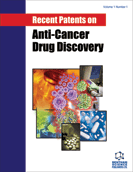Abstract
Epidermal growth factor receptor (EGFR) is a tyrosine kinase receptor that activates downstream signaling pathways, including the Ras-MEK-Erk and PI3K-AKT pathways, leading to cell proliferation, resistance to apoptosis, angiogenesis and the ability to metastasize. EGFR overexpression is a significant finding in cancer, particularly in head and neck cancer, where it is also associated with a poor prognosis. In recent years, several molecules have been designed to inhibit EGFR activation. Among the many available anti-EGFR drugs, only cetuximab was approved for the treatment of head and neck cancers. However, no predictive biomarkers of cetuximab response are currently known. In the present review, we provide an updated assessment of EGFR biology and its clinical impact in head and neck cancers. A special emphasis is placed on novel patents of EGFR-inhibitors that are anticipated to diversify the anti-EGFR therapies available to treat head and neck cancers. In particular, we outline a new class of irreversible multi-target inhibitors (e.g. afatinib, icotinib, CUDC-101), which may significantly contribute to new head and neck cancer therapies.
Keywords: Anti-EGFR patents, EGFR, EGFR overexpression, head and neck squamous cell carcinoma, tyrosine kinase inhibtors, targeted therapies.































